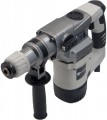Real power
The power given out by the perforator directly to the drill or other working equipment. This figure is inevitably lower than the power consumption (see below) due to energy losses in the tool mechanisms.
In general, higher net power means more efficiency and productivity; the reverse side of these advantages is an increase in price, energy consumption, dimensions and weight (however, the latter is not always a drawback for rotary hammers). In addition, note that tools with similar useful power values may differ in the ratio of chiseling speed and impact power: remember, a higher frequency means less energy for each individual impact, and vice versa. So the big numbers in this paragraph can mean both high efficiency when working with hard, stubborn materials, and good performance on relatively simple tasks; these features need to be specified separately.
Also, by the ratio of useful and consumed power, one can evaluate the efficiency of the tool in terms of energy consumption: the lower the power consumption (with the same useful power), the more efficient this model is. The downside of energy efficiency is often increased cost, but it can be recouped fairly quickly in energy savings, especially if you work long hours and often.
Power consumption
Rated power consumed by the rotary hammer during operation. Usually, the maximum power consumption in normal operation is taken as the nominal power.
In general, the higher this indicator, the heavier and more performant the rotary hammer is, the more advanced its performance usually turns out to be. On the other hand, the electricity consumption of such tools is high. In addition, note that with the same power consumption, the actual set of individual characteristics for different tools may be different. For example, frequency and impact energy are inversely related, and for the same power input, higher frequency usually means less individual impact energy. So, according to this parameter, it is worth evaluating only the overall level of the instrument; for accurate selection for specific tasks, you need to pay attention to more specific characteristics.
Also note that power consumption data can be useful for some tasks related to catering — for example, if a construction site is powered by an autonomous generator and you need to estimate the load on this energy source.
Rotation speed
The speed of rotation of the working equipment provided by the rotary hammer. Usually, this indicates the speed at idle, without load; rated load speeds can be further specified in the characteristics (see below), but this is rare, and this parameter is still considered the main characteristic. It is also worth mentioning that in the presence of a speed controller (see "Functions"), the maximum speed value is given here.
When working in the main mode — drilling with impact — the rotation of the equipment is used mainly to remove waste from the hole, and the revolutions here are of no fundamental importance (they can be very low). Therefore, it is worth paying attention to this indicator mainly in cases where the rotary hammer is planned to be often used for conventional drilling, without impact. And here it is worth proceeding from the fact that
high speeds increase productivity and contribute to accuracy when working with some materials, but reduce torque (compared to tools with the same engine power). So for heavy work with hard, stubborn materials, relatively "slow" tools are usually better suited.
Note also that drilling is not the main task of rotary hammers; therefore, their rotation speeds are noticeably lower than those of the same
drills. On the other hand, in this case, low speeds are often compensated by powerful engines and high torque, which makes it possible to effectively drill holes
...of a fairly large diameter, including using crowns.Wood drilling max. ⌀
The maximum diameter of a tool that can be used with a rotary hammer when drilling in wood (and, accordingly, the maximum diameter of the resulting hole). With a large drilling diameter, the loads on the device increase, and some models may simply not be designed for them (despite the technical possibility of installing tools of the appropriate diameter), as a result, it is not worth exceeding the maximum specified diameter, because. this may damage the instrument.
Weight
The weight of a fully assembled rotary hammer (in the case of battery power, with a standard battery installed). Unlike many other types of equipment, in the case of rotary hammers, light weight is far from always an advantage. So, heavy models are better suited for professional use — they are less prone to vibrations and, usually, are stronger, which is important when working with difficult-to-cut materials for a long time. But for small, simple works of short duration, a lot of weight is not required, and in this case,
light models are useful, which do not require significant effort to hold on weight.

